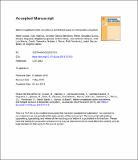Por favor, use este identificador para citar o enlazar a este item:
http://hdl.handle.net/10261/188218COMPARTIR / EXPORTAR:
 SHARE SHARE
 CORE
BASE CORE
BASE
|
|
| Visualizar otros formatos: MARC | Dublin Core | RDF | ORE | MODS | METS | DIDL | DATACITE | |

| Campo DC | Valor | Lengua/Idioma |
|---|---|---|
| dc.contributor.author | Louzao, Maite | es_ES |
| dc.contributor.author | Valeiras, J. | es_ES |
| dc.contributor.author | García-Barcelona, Salvador | es_ES |
| dc.contributor.author | González-Quirós, Rafael | es_ES |
| dc.contributor.author | Nogueira, Enrique | es_ES |
| dc.contributor.author | Iglesias, Magdalena | es_ES |
| dc.contributor.author | Bode, Antonio | es_ES |
| dc.contributor.author | Vázquez, José Antonio | es_ES |
| dc.contributor.author | Murcia, José Luis | es_ES |
| dc.contributor.author | Saavedra, Camilo | es_ES |
| dc.contributor.author | Pierce, Graham J. | es_ES |
| dc.contributor.author | Fernández, Ruth | es_ES |
| dc.contributor.author | García-Barón, Isabel | es_ES |
| dc.contributor.author | Santos, M. Begoña | es_ES |
| dc.date.accessioned | 2019-08-14T08:32:30Z | - |
| dc.date.available | 2019-08-14T08:32:30Z | - |
| dc.date.issued | 2019 | - |
| dc.identifier.citation | Continental Shelf Research 186: 77-87 (2019) | es_ES |
| dc.identifier.issn | 0278-4343 | - |
| dc.identifier.uri | http://hdl.handle.net/10261/188218 | - |
| dc.description | 11 pages, 5 figures, 4 tables | es_ES |
| dc.description.abstract | In the last few decades, there has been a remarkable development of niche models to help understand the ecological response of species to current rapid environmental changes. In the present study, we applied niche modelling to the megafauna community of shelf waters of the northwestern (NW) and northern Iberian Peninsula in order to analyse the coexistence of different species taking into consideration their niche preferences. The Spanish Institute of Oceanography conducts the PELACUS multidisciplinary survey annually to assess pelagic fish stocks and collect information on the status of other ecosystem components, such as oceanographic conditions, phytoplankton, zooplankton and marine megafauna. Using data collected from these surveys, we developed niche models for 14 marine megafauna taxa (3 cetaceans, 10 seabirds and 1 fish) incorporating multi-trophic ecological descriptors collected simultaneously during the surveys alongside the more commonly used oceanographic variables (e.g. chlorophyll a and sea surface temperature). Megafauna niche models were developed by pooling observations from 2007 to 2013 and were found to be driven by mean fish biomass and its variability, in addition to sea surface temperature. Hierarchical clustering identified four distinct megafauna assemblages, the first comprising wide-ranging species and the other three associated with shelf-slope waters in Galicia, coastal/shelf waters in Galicia, and the eastern Cantabrian Sea, respectively. Community-level hotspot areas were found in shelf and shelf-break sectors of Galicia, along with small diversity spots scattered throughout the Cantabrian coastal area. Our results showed that synoptically collected survey-based ecological descriptors, especially acoustic-based preyscapes, were among the most important variables explaining megafauna niche preference. These findings highlight the advantage of using integrated ecosystem surveys to collect simultaneous information on a suite of ecosystem components for spatial assessments | es_ES |
| dc.description.sponsorship | Surveys were funded by the Instituto Español de Oceanografía's ECOPEL project, partially co-funded by the European Union Data Collection Framework program. Additional funding was contributed by the CONPELHAB (Marie Curie Career Integration Grant PCIG09-GA-2011-293774), REPRODUCE (MariFish 8120-09-9), LOTOFPEL (Plan Nacional de I+D+I, CTM 2010-16053) and CHALLENGES (CTM2013-47032-R) projects. Maite Louzao was funded by Juan de la Cierva (JCI-2010-07639) and Ramón y Cajal (RYC-2012-09897) postdoctoral contracts | es_ES |
| dc.language.iso | eng | es_ES |
| dc.publisher | Elsevier | es_ES |
| dc.relation.isversionof | Postprint | es_ES |
| dc.rights | openAccess | en_EN |
| dc.subject | Niche coexistence | es_ES |
| dc.subject | Marine megafauna | es_ES |
| dc.subject | Preyscapes | es_ES |
| dc.subject | Species distribution models | es_ES |
| dc.subject | Integrated ecosystem surveys | es_ES |
| dc.title | Marine megafauna niche coexistence and hotspot areas in a temperate ecosystem | es_ES |
| dc.type | artículo | es_ES |
| dc.identifier.doi | 10.1016/j.csr.2019.07.013 | - |
| dc.description.peerreviewed | Peer reviewed | es_ES |
| dc.relation.publisherversion | https://doi.org/10.1016/j.csr.2019.07.013 | es_ES |
| dc.identifier.e-issn | 1873-6955 | - |
| dc.embargo.terms | 2021-09-15 | es_ES |
| dc.relation.csic | Sí | es_ES |
| oprm.item.hasRevision | no ko 0 false | * |
| dc.type.coar | http://purl.org/coar/resource_type/c_6501 | es_ES |
| item.openairetype | artículo | - |
| item.languageiso639-1 | en | - |
| item.fulltext | With Fulltext | - |
| item.grantfulltext | open | - |
| item.cerifentitytype | Publications | - |
| item.openairecristype | http://purl.org/coar/resource_type/c_18cf | - |
| Aparece en las colecciones: | (IIM) Artículos | |
Ficheros en este ítem:
| Fichero | Descripción | Tamaño | Formato | |
|---|---|---|---|---|
| Marine_megafauna_2019.pdf | 1,4 MB | Adobe PDF |  Visualizar/Abrir |
CORE Recommender
SCOPUSTM
Citations
10
checked on 20-abr-2024
WEB OF SCIENCETM
Citations
10
checked on 24-feb-2024
Page view(s)
217
checked on 07-may-2024
Download(s)
169
checked on 07-may-2024
Google ScholarTM
Check
Altmetric
Altmetric
NOTA: Los ítems de Digital.CSIC están protegidos por copyright, con todos los derechos reservados, a menos que se indique lo contrario.
